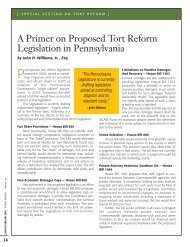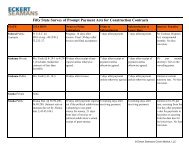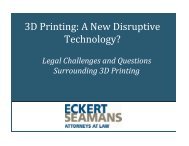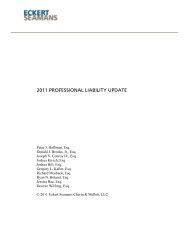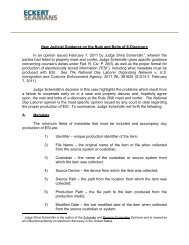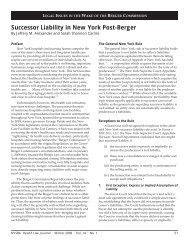2012 PROFESSIONAL LIABILITY UPDATE - Eckert Seamans
2012 PROFESSIONAL LIABILITY UPDATE - Eckert Seamans
2012 PROFESSIONAL LIABILITY UPDATE - Eckert Seamans
Create successful ePaper yourself
Turn your PDF publications into a flip-book with our unique Google optimized e-Paper software.
The Pennsylvania Supreme Court reversed and held that a question of fact existed as tothe accrual of the cause of action under the discovery rule precluded summary judgment. Thecourt noted that there was “evidence of potential sources of confusion, in the assertedunwillingness or inability on the part of Dr. El-Daief to recognize injury or cause.” Id. at 180.The court further held that “[w]hile we reiterate that knowledge of ‘injury’ and ‘cause’ does notrequire a precise medical diagnosis, we decline to hold as a matter of law, that a lay person mustbe charged with knowledge greater than that which was communicated to her by multiplemedical professionals involved in her treatment and diagnosis.” Id.The court also held that “with full appreciation of the additional requirement imposedupon plaintiffs to obtain a certificate of merit under Rule 1042.3, we decline to retool thediscovery rule specific to medical malpractice actions in light of the procedural rule…we believethe rules allow sufficient flexibility to avoid untenable results.” Id. at 182. The court furthernoted that the current discovery rule was adequate in providing the plaintiffs with their day incourt as well as protecting the defendants from stale claims. Id. at 184-85.A concurring and dissenting opinion was filed and Justice Baer noted that he agreed withthe majority opinion that the action was not time-barred by the statute of limitations. He stated:Id. at 187-88.I am compelled to write, however, as I believe the convergence ofthis Court’s adoption of the certificate of merit (COM)requirements and our application of the discovery rule in medicalmalpractice cases has the potential for unbridled mischief.Application of current Pennsylvania Jurisprudence placesplaintiffs. Like Appellant, in the precarious position of beingconstrained to file a lawsuit before they know whether resultingsymptoms are linked to a physicians malpractice or are commonside effects of the procedure performed. Such an absurdconsequence resulting from the application of these twocountervailing principles of law should not be countenanced. Toavert this fundamental unfairness, we should construe thediscovery rule so as to toll the statute of limitations until theplaintiff obtains, or with the exercise of due diligence should haveobtained, medical evidence sufficient to enable the plaintiff to linkher injury to the acts of the defendant. In the instant case, there isno genuine issue of material fact that the lawsuit was filed withintwo years of when the Appellant, after diligent investigation,obtained medical evidence connecting her injury to the AppelleeDr. El-Daief’s actions. Thus, in my view, Appellant’s action wastimely filed as a matter of law . . .In Wilson v. King, No. 06-CV-2608, 2010 WL 1071651 (E.D. Pa. March 22, 2010), theDefendants, filed a Motion for Summary Judgment against Plaintiff Edward K. Wilson, whoseoriginal and amended complaints alleged that the Defendants engaged “in a civil conspiracy to85




